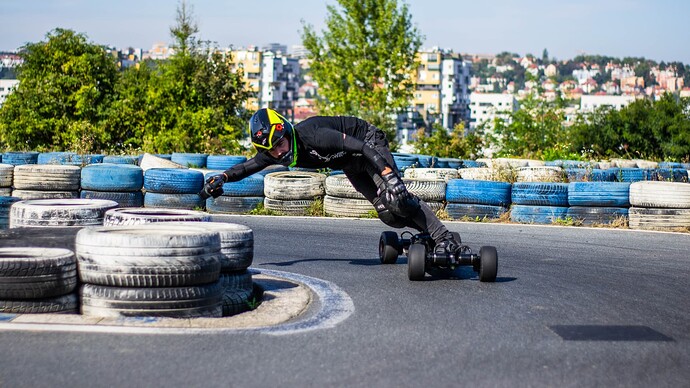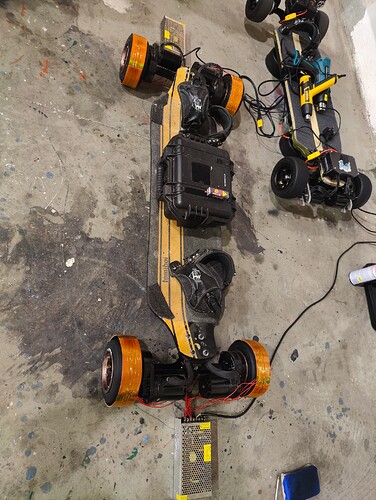Hey! I’m new to the forum and while I love karting at a hobby level, there’s one thing I am even more passionate about - racing esk8s - electric skateboards - on kart tracks. Don’t let the word “skateboard” turn you off - on some tracks the fastest guys from our hobby can challenge kart lap times. If you are interested in the topic, bear with me until the end, if not, no worries. But I’d appreciate some input on gokart tire selection to advance this sport. TLDR: the post starts with introduction to racing esk8s, how I got to the realization of trying kart tires on my esk8, and then I am asking for help so I can select the right kart tires in the last paragraph.
Below is a picture of me turning at around 1.4G at Kartplanet Prague.
This is a nice youtube series of one of the racing leagues over the 2024 season with some commentary for anyone interested in the sport: https://www.youtube.com/playlist?list=PLNcG9e7JvShOe43Kz1jOAy-r1m3orNaM3
Electric skateboard racing is still in it’s infancy, I’ll give you a short overview to catch up to what it really is. Most of the skateboards that are raced on at a competitive level are racer’s shed creations. Zero restrictions apply so long as we have 4 wheels, electric propulsion, and turn by leaning to the side. This along with the small form factor of electric motors has lead to crazy power to weight ratios even after accounted for rider weight - the best boards are not limited by power at lower speeds, but rather by traction.
My 4WD in the picture above can put down around 1200N of force theoretically after having accounted for efficiency while accelerating 110kg total - meaning about 1.1G theoreticaly acceleration - yikes. The highest I actually measured so far is about 0.9G acceleration, that was dancing on the limit of traction and not full torque. 4WD can deliver the same amount of deceleration while braking - we don’t have mechanical brakes, so therefore we need a motor on each wheel to have front brakes, which cuts lap times a fair amount, especially on shorter more technical tracks.
There’s a very interesting aspect to esk8 racing that doesn’t really apply to most other motorsports - the weight of the esk8 is around 20-30kg (44-66 lbs), whereas the weight of the rider is much more, usually 80kg (180lbs) or higher… Combine this with the fact that we are essentially standing on a wooden plank or a steel chassis, we can move the center of gravity around way move than it’s possible in most other motorsports. And we actually really need to move the weight around - without that we can’t turn - and if we give throttle input without moving our weight, well we won’t really be standing anymore.
However as our sport is so new, the optimal equipment is not yet figured out. This is especially true for tires, and some chassis development is still taking place - noone uses tires with an actual speed rating, we just hope they won’t blow up on us and balance them if needed. Some people are using RC dragster car tires and pull close to 2G cornering on them. Those tires however cost 1.5x per piece compared to a gokart tire, and due to their small size of 6" diameter, they limit how the chassis can be built.

There’s also race tires around the 6" size tubed and tubeless specifically built for esk8 racing, however I am not convinced those are the right choice either. They are just the easy choice.
Without going too complex into the chassis setup, the further the standing platform is above the axle, the more force it takes to steer in high G turns. If the standing platform is inline with the axle the steering feels great, however because the deck needs to be able to lean just like a skateboard deck would, it needs a good amount of clearance. You will end up either compromising the amount of lean you can have (therefore the steering will feel more twitchy) or need to increase the chassis height therefore you’ll have a hard time countering steering forces.
In the past year or so I’ve been experimenting with a few sets of lawnmower slicks - yep you heard that right ![]() that’s what I’ve been pulling about 1.4G on in the picture above. These are 9x3.5 slicks around 70A on the durometer scale. The compound is too hard, and they need every condition to be just right to heat up properly, but they allowed a nicer chassis setup for my board. This allowed me to have the axle inline with the standing platform so that the steering doesn’t tighten up on high G turns, while not having to take sacrifices on the amount of deck lean I wanted to have, and even resulted in a bit of excess ground clearance.
that’s what I’ve been pulling about 1.4G on in the picture above. These are 9x3.5 slicks around 70A on the durometer scale. The compound is too hard, and they need every condition to be just right to heat up properly, but they allowed a nicer chassis setup for my board. This allowed me to have the axle inline with the standing platform so that the steering doesn’t tighten up on high G turns, while not having to take sacrifices on the amount of deck lean I wanted to have, and even resulted in a bit of excess ground clearance.
Not too long after the most prominent race team in esk8 (SRB) started experimenting with 8.5" ninebot kart tires with decent success as well, and just recently brought out a chassis where the standing platform is below the axle, resulting in a power steering effect for those high G turns.
However I have big plans for the 2025 race season. I’m increasing battery power to 23-24kW and I’m rebuilding my chassis from scratch from bent and welded sheet metal, that allows an adjustable ride height, taking the standing platform from about inline to well below axle - giving me plenty of power steering as I prefer an easy steering - and the ability (and, well, the need) to run gokart tires if I actually run the chassis that low. Going from the total amount of weight, and the fitment / size, I determined that the ideal tire size for me is a front gokart tire size. And my findings so far are that I prefer same size front to back on an esk8.
So I’ll need something 10" tall. I bought some 5"x5" rims, and I am getting some custom wheel hubs manufactured soon.
There’s a couple things I am not sure on however, and that’s why I’m here. I don’t know much about gokart tires to be fair. I’ve been thinking that if I go for some harder duro, I definitely need to compensate by going less in width so that I can heat it up still. So there’s two ways I can see:
Either something around 10x3.60-5 in a medium-soft compound, or 10x4.6-5 in a soft compound. Honestly I think the larger width seems like a better choice if I can go super soft compound, because I when I fall I tend to mess up the rims of the rim extends past the tire - which would definitely be the case on the smaller width. But total weight is only around 110-120kg / 240-260 lbs, so I’m a little hesitant if I could heat up extra width.
Can you kart guys recommend me some good, really grippy, soft front tires? It doesn’t matter if it’s known to bog down engines because it’s so grippy - I’ve got plenty of power to spare. I’ve been thinking primarily MG yellow or maybe Vega White so far, but I really don’t have much knowledge about kart tires. Ideally the tire should heat up fast relative to kart tires, as I am more likely to struggle with low temps rather than high temps. I’m mostly going to be using it on asphalt. I wouldn’t mind if I could get over 100 km, maybe even over 200 km racing out of a set before they really fall off a cliff, but if I can’t - that’s one thing I can live with.



